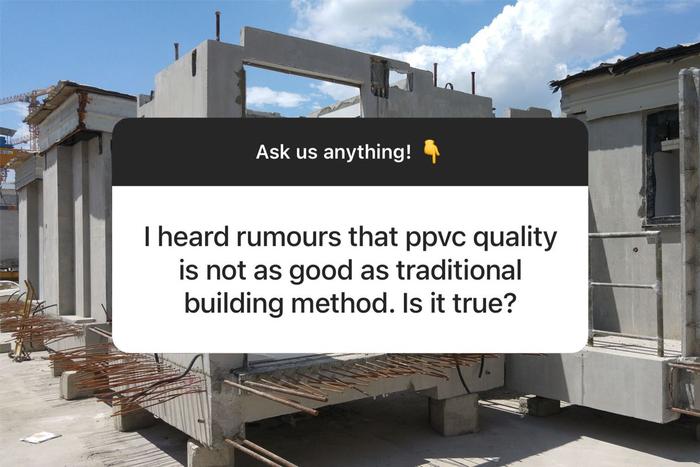Here’s the full lowdown from the people in charge.
Although the insides of BTO flats that are constructed using traditional methods and those manufactured using PPVC (or Prefabricated Prefinished Volumetric Construction, if you prefer) are almost indistinguishable from each other, the process of building them couldn’t be more different.

Photo credit: HDB
While most of the construction work for conventional flats is done on-site, the bulk of the labour for PPVC units is instead performed off-site.

Image credit: HDB MyNiceHome
Essentially, this construction technique involves pre-casting common BTO flat components, like household shelters, refuse chutes, and even ceiling beams, at a separate location (away from the neighbourhood) before delivering and assembling them at their intended locale.
Because of this, PPVC presents several tangible benefits for homeowners – not least the ability to move into a BTO flat faster. But for more details, as well as answers from HDB MyNiceHome to your burning questions about PPVC flats received on Instagram (@qanvast), keep scrolling!
PPVC flats aren’t as good as HDB flats built using traditional methods. Is that true?

HDB: Just like other HDB flats, PPVC homes are of good quality! For example, one advantage that the PPVC method offers is secure waterproofing; due to how PPVC modules are designed and fabricated, there is improved water tightness in wet areas.
Better workmanship and higher quality building components are also ensured due to the lower reliance on manual labour on-site, as well as the production of PPVC modules in controlled factory environments.

Moreover, PPVC flats come ready with floor and wall finishes, internal doors, window frames, and sanitary fittings – and with these essentials already in place, homeowners can expect to do less renovation work.
Must interior designers and contractors be certified to be able to work on PPVC flats?

HDB: No, interior designers and contractors don’t have to be certified beforehand to work on PPVC flats. However, for your home makeover, you must engage an HDB Registered Renovation Contractor who is familiar with HDB renovation guidelines and requirements.
These include regulations pertaining to structural integrity (e.g., getting the relevant permits for demolition works or building non-structural partition walls), electrical and plumbing work, as well as other aspects of renovating an HDB flat.
What renovation works can be done in a regular HDB flat, but not a PPVC unit?

HDB: There’s no difference between the renovation works that can be done in PPVC and non-PPVC flats. That said, each HDB precinct possesses unique features, designs, as well as colour schemes – these characteristics call for renovation restrictions to ensure the estate’s overall appearance is kept intact.

Valley Spring @ Yishun, the first-ever HDB development completed in 2020 using the PPVC method.
To enquire about restrictions that are specific to your HDB development, you may visit HDB InfoWEB, which will give you a list of additional renovation dos and don’ts after keying in your block number and street name.

Example of additional renovation restrictions that apply for Valley Spring @ Yishun.
Are we allowed to hack the non-structural walls in PPVC flats?

HDB: Yes, it may be possible to hack some of the non-structural walls in your PPVC flat. But take note, the same regulations for demolishing non-load bearing partitions applies to the process of renovating any HDB flat.

A 3-room BTO flat at Valley Spring @ Yishun. (View this project by The Interior Lab)
Some examples include:
- All demolition or alteration of non-load bearing reinforced concrete elements (e.g., partition walls, party walls) can only be carried out with HDB’s approval.
- If steel beams are discovered during the hacking process, the works are to be stopped and HDB must be informed immediately.
For a more comprehensive list of HDB renovation guidelines concerning the demolition and erection of walls, check out this webpage on guidelines concerning building works.
Is it true that the floor tiles in PPVC units cannot be hacked?

HDB: You’re free to change the flooring in most areas of your PPVC flat, subject to HDB guidelines and restrictions. For instance, if you’re replacing your home’s flooring, the total thickness of the new floor finish and screed must not exceed 50mm.

View this project by Prologue Studio
Likewise, for both PPVC and non-PPVC flats, homeowners aren’t allowed to hack the provided bathroom wall and floor finishes in the first 3 years. This is to prevent any damage to the waterproofing layer, which could result in inconveniences (read: cracks, mould issues, and structural defects) for both you and your neighbours.
Instead, if you’d like a different look for your bathroom, you may lay new tiles on existing wall/floor finishes.
What are some common defects to look out for in a PPVC flat?

HDB: There aren’t any defects that are specific to PPVC flats. Regardless, if you discover any issues in your new BTO flat (PPVC or otherwise), do report them to your estate’s Building Services Centre within 1 month of your key collection for rectification by HDB.
Also, along with a checklist, here’s a simple guide on how to conduct a defects inspection in your new HDB flat.

Image credit: HDB MyNiceHome
What should I take note of to keep my PPVC flat well-maintained in the future?

HDB: PPVC flat or not, conducting regular checks on the windows, floor finishes, ceilings, tiles, walls and other parts of your home will help keep it in tip-top condition for the years to come. And if you’d like a more detailed guide on how to do these checks yourself, here’s one!
This article was adapted from MyNiceHome, HDB’s official website for all things related to home buying and renovation in Singapore. Check out the original article here.

 Get a budget estimate before meeting IDs
Get a budget estimate before meeting IDs